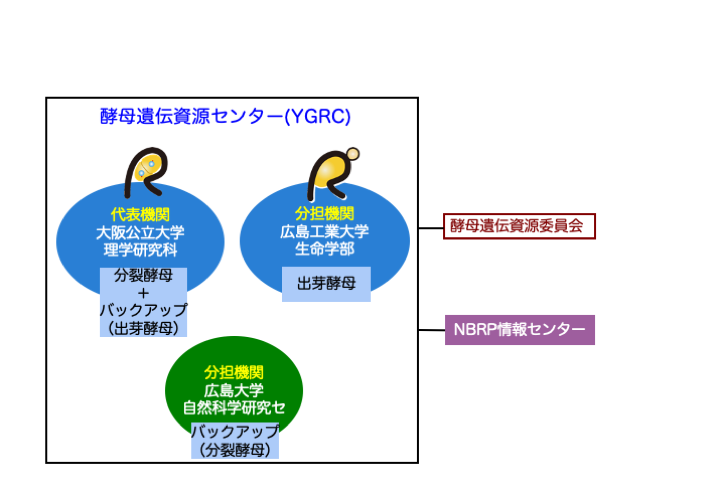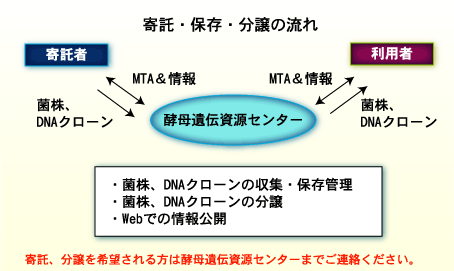NBRP酵母とは
このページでは、ナショナルバイオリソースプロジェクト(NBRP)酵母分野の概要をご紹介します。
目的
酵母は醸造産業の担い手として人類にとってなくてはならない微生物です。それだけではなく、酵母は生命科学領域でモデル生物として重要な役割を果たしています。
出芽酵母(Saccharomyces cerevisiae)、分裂酵母(Schizosaccharomyces pombe)では全ゲノムのシークエンスが終わり、今や本格的なゲノム規模での機能解析の時代に突入しました。実験モデル生物としての重要さ今後も当分変わることはないでしょう。
さまざまな酵母研究のためにはまず、酵母菌株やDNAクローンなどのバイオリソースを入手する必要があります。これまではほとんどが研究者間のやりとりで行われてきました。平成14年度から文部科学省バイオリソースプロジェクト(酵母)がスタートしました。このプロジェクトでは、遺伝学研究用の酵母菌株、ライブラリーやプラスミドなどのDNAを収集保存し、研究者に提供する事業を行っています。
組織
酵母遺伝資源の収集、保存、提供を行う事業主体として、酵母遺伝資源センター(YGRC)を構築しました。大阪公立大学, 広島工業大学, 広島大学の3つの研究室が連携し、センターを支えています。プロジェクト推進母体と研究コミュニティとの連携を強め、適正な運営と協力体制を築くため、全国の酵母研究室を網羅した運営委員会が組織されています。
組織図

酵母遺伝資源運営委員会
| 水沼 | 正樹 | 広島大学・大学院統合生命科学研究科 | (委員長) |
| 赤田 | 倫治 | 山口大学・大学院医学系研究科 | |
| 赤尾 | 健 | 酒類総合研究所 | |
| 荒木 | 弘之 | 情報・システム研究機構 データサイエンス共同利用基盤施設/国立遺伝学研究所 | |
| 鎌田 | 芳彰 | 基礎生物学研究所・多様性生物学研究室 | |
| 川向 | 誠 | 島根大学・生物資源科学部 | |
| 北村 | 憲司 | 広島大学・自然科学研究支援開発センター | (分担機関課題実施者) |
| 北本 | 宏子 | 農研機構・農業環境変動研究センター | |
| 後藤 | 祐平 | 基礎生物学研究所・定量生物学研究部門 | |
| 作野 | 剛士 | 大阪大学・生命機能研究科 | |
| 篠原 | 美紀 | 近畿大学・農学部 | |
| 杉山 | 峰崇 | 広島工業大学・生命学部 | (分担機関課題実施者) |
| 須摩 | 美智子 | 沖縄科学技術大学院大学 | |
| 竹川 | 薫 | 九州大学・大学院農学研究院 | |
| 東田 | 英毅 | 株式会社ちとせ研究所 | |
| 中村 | 太郎 | 大阪公立大学 大学院理学研究科 | (代表機関課題実施者) |
| 原島 | 俊 | 崇城大学・生物生命学部 | |
| 平岡 | 泰 | 大阪大学・生命機能研究科 | |
| 守屋 | 央朗 | 岡山大学・異分野融合先端研究コア | |
| 山岸 | 裕美 | アサヒビール(株) | |
| 山下 | 朗 | 基礎生物学研究所・新分野創成センター |
酵母遺伝資源センター(YGRC)
つぎの2つの機関が緊密に連携を保ちながら、分裂酵母 (S. pombe)と出芽酵母 (S. cerevisiae)を分担して、YGRCとしての活動を行っています。
分裂酵母
スタッフ:
中村太郎 (代表・理学研究科教授)
連絡先:
〒558-8585 大阪市住吉区杉本3-3-138
大阪公立大学大学院理学研究科
酵母遺伝資源センター
E-mail: contactus-yeast shigen.info
shigen.info
中村太郎 (代表・理学研究科教授)
連絡先:
〒558-8585 大阪市住吉区杉本3-3-138
大阪公立大学大学院理学研究科
酵母遺伝資源センター
E-mail: contactus-yeast
 shigen.info
shigen.info出芽酵母
スタッフ:
杉山峰崇(代表・生命学部教授)
連絡先:
〒731-5193 広島市佐伯区三宅2-1-1
広島工業大学 生命学部
E-mail: contactus-yeast shigen.info
shigen.info
杉山峰崇(代表・生命学部教授)
連絡先:
〒731-5193 広島市佐伯区三宅2-1-1
広島工業大学 生命学部
E-mail: contactus-yeast
 shigen.info
shigen.infoバックアップ
スタッフ:
北村憲司(自然科学研究支援開発センター准教授)
連絡先:
〒739-8527 東広島市鏡山1-4-2
広島大学自然科学研究支援開発センター
E-mail: contactus-yeast shigen.info
shigen.info
北村憲司(自然科学研究支援開発センター准教授)
連絡先:
〒739-8527 東広島市鏡山1-4-2
広島大学自然科学研究支援開発センター
E-mail: contactus-yeast
 shigen.info
shigen.info事業のご案内
酵母バイオリソースの収集、保存、提供作業は、次のような流れになっています。

寄託
研究者からの菌株等の寄託をお願いしています。担当するYGRCにメールなどでご連絡ください。大量のリソースを寄託される場合はスタッフの派遣などで対応いたします。寄託にあたっては「酵母遺伝資源寄託同意書」を取り交わします。その中で、利用者に提供する際の条件をリソースごとに定めることができます。寄託して頂いたリソースに対して研究者から提供依頼があった場合は、培養、発送などすべてYGRCが作業を行いますので、研究者の負担が軽減されるメリットがあります。
保存・品質管理
保存菌株はグリセロール中で-80℃で凍結保存しています。また、一部、表現型のチェックも行っています。掛け合わせ、突然変異処理などにより、新規の菌株の作成も行っています。
データベースの作成と利用
菌株とプラスミドの情報はデータベース化しており、希望するリソースがあるかどうかを検索することができます。
提供
YGRCで保存されている、菌株、ライブラリー、プラスミドなどを入手したい場合は、Webでオーダーしてください。迅速に郵送、宅配便などによりお送りします。提供にあたっては「酵母遺伝資源提供同意書」を取り交わします。リソースによっては寄託者の提供承諾書などが必要です。リソースごとに定められた利用条件を守ってください。
